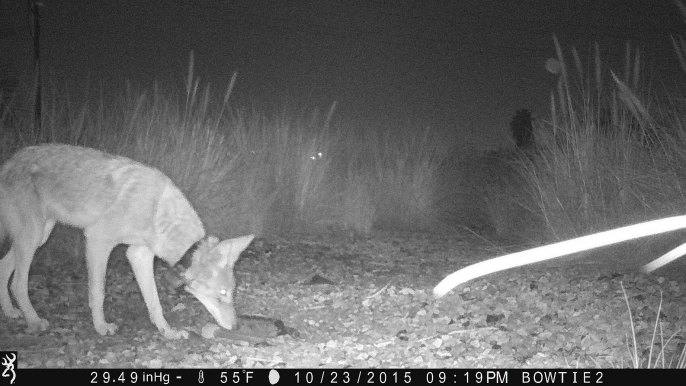|
You are viewing ARCHIVED content published online before January 20, 2025.
Please note that this content is NOT UPDATED, and links may not work. For current information,
visit https://www.nps.gov/aboutus/news/index.htm.

Photo Courtesy of the National Park Service
Contact: Zach Behrens, 805-370-2385 Contact: Kate Kuykendall, 805-370-2343 THOUSAND OAKS, Calif. -- A radio collared coyote found dead in a City of Los Angeles park last December is believed to have died by drowning, the National Park Service announced today. The female subadult coyote, known as C-146, was tracked for two months as part of researchers’ efforts to better understand how coyotes live in extremely urbanized areas. “It’s really disappointing to lose her,” said Justin Brown, a National Park Service biologist who has been tracking her since she was captured on September 23. “The data we were collecting from her movements were very interesting.” In the short time Brown tracked her movements via a GPS collar, her travels displayed unusual behavior for a species that is territorial. Since captured near the L.A. River in Northeast L.A., she traveled as far south as downtown Los Angeles via the L.A. River, throughout Elysian Park, and into the Westlake neighborhood where she met her fate in MacArthur Park. C-146 was found on December 4 near the park’s lake, which prompted the City of Los Angeles Department of Recreation and Parks to notify the National Park Service. Her body, which was found covered in algae and soaking wet, was sent to the California Animal Health & Food Safety Lab in San Bernardino for a necropsy. Lab results identified the cause of death to be drowning. “In the location she was found dead, it would have been extremely difficult for her to climb out due to the steep cement walls along the lake,” explained Brown. “But I’m unsure why C-146 went into the lake. She may have jumped in to pursue a duck or waterfowl. She also may have fallen in while trying to get a drink, as animals commonly become very thirsty when exposed to anticoagulants, high levels of which were found in her body.” Lab results detected first- and second-generation anticoagulant rodenticides in her liver. Anticoagulant rodenticides, which are used in rat poison, canwork their way up the food chain. While first-generation anticoagulant rodenticides are widely available for purchase, second-generation anticoagulant rodenticides were banned by recent California legislation, although they can still be purchased by licensed applicators. The anticoagulant rodenticides found in C-146 were brodifacoum, bromadiolone, difethialone, and diphacinone. Alternatives to rat poison can be found here. The National Park Service has been studying L.A.’s most urban coyotes since May 2015. While coyotes have been widely studied, very little research exists on coyotes in the most extreme urban landscapes such as Los Angeles. Two other coyotes, C-144 and C-145, have also been studied in the area. Collars on both of those coyotes unfortunately died prematurely. The death of C-146 leaves the study on hold until new coyotes in the Los Angeles basin are captured and outfitted with GPS collars. Since 1996, the National Park Service has been studying carnivores in and around the Santa Monica Mountains to determine how they survive in an increasingly fragmented and urbanized environment. During the course of the study, biologists have radio-tracked more than 300 bobcats, 140 coyotes, and 47 mountain lions. Santa Monica Mountains National Recreation Area (SMMNRA) is the largest urban national park in the country, encompassing more than 150,000 acres of mountains and coastline in Ventura and Los Angeles counties. A unit of the National Park Service, it comprises a seamless network of local, state and federal parks interwoven with private lands and communities. As one of only five Mediterranean ecosystems in the world, SMMNRA preserves the rich biological diversity of more than 450 animal species and 26 distinct plant communities. For more information, visit www.nps.gov/samo. |
Last updated: August 1, 2019
